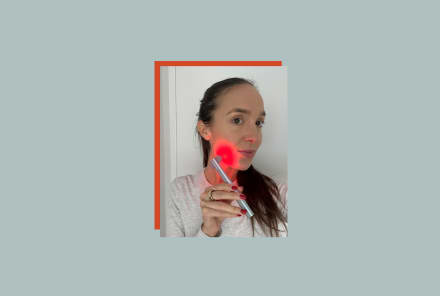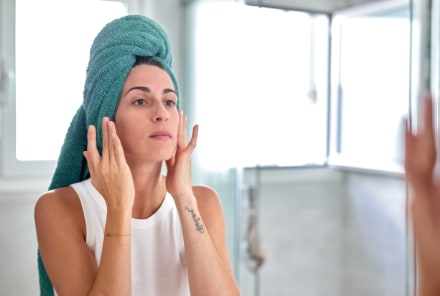Advertisement
Your Guide To Cuticle Care: How To Cut Them Safely + 10 Other Expert Tips

Your cuticles—tiny little pieces of skin that they are—wield so much power over your nail health. That's because those cuticles have a special purpose (more in a moment) for keeping your claws healthy and strong: Neglect your cuticles, and chances are your nails also appear brittle and cracked, if not irritated; pamper the skin with the tips below, and your nails will naturally look high-gloss and strong.
Consider this your guide to cuticle care: where they are, how to clip them safely, and the best expert advice we could get our paws on.
What part of the nail bed is your cuticle?
"The cuticle is actually a layer of clear dead skin that hangs around the nail plate," says Amy Lin, the founder of sundays—a nail care brand focused on wellness. It rims the base of the nail bed, as it creates a barrier for your growing nails—so the vulnerable, new spots aren't exposed to any bacteria as they grow.
Is it safe to cut your cuticles?
Well, yes and no. The cuticles have a purpose (i.e., shielding your growing nails from the elements), so you don't want to peel them entirely off your nails—otherwise, aggressors can sneak their way in and you run the risk of infection.
You can, however, clip the excess dry, dead skin hanging off your cuticles; so when professionals cut your cuticles, what they're really doing is nipping that extra dry skin.
Although, it can be pretty difficult for the average at-home nail artist to differentiate between the extra dead skin around your nails versus your actual cuticles, which is why Lin recommends waiting for a professional if you can hold off. They can cut the surrounding skin without causing any potential harm.
If your cuticles are glaringly frayed, you can clip them at home safely: "Take your cuticle pusher and push your cuticle back toward the knuckle," says celebrity manicurist Deborah Lippmann in our DIY mani guide.
If you don't have a pusher, you can also use a cotton swab or even the end of your file (just wrap the end of the file with a tissue so the abrasive grit doesn't scrape against the nail as you push). "If you have a piece of skin that's still hanging after you've properly pushed it, you can take your cuticle nipper and just nip that tiny piece of skin. You never want to nip all the way around."
10 top tips for caring for your cuticles.
Experts agree: Rather than clipping every single fray (and risk nipping too far into the necessary seal of skin), you can take steps to keep those cuticles hydrated and healthy—and prevent them from fraying in the first place.
Don't pick or bite!
Similar to cutting too close to the base, picking or biting the frays can only lead to more damage (and swollen tips). If you're a frequent nail-biter or cuticle picker, it can be tough to quit the habit—but try these tips to nip the nail-biting for good.
Some highlights: A bit of mindfulness, like breathwork or going for a quick walk, can be helpful for some, while others may need to find other ways to keep their hands busy (like squeezing a stress ball).
Use cuticle oil.
To keep the cuticles moisturized (thus preventing frays), add a cuticle oil to your daily routine: Many options include fatty acids and vitamins that nourish the nails and fill in any micro-cracks in the surrounding skin (well, our picks certainly do). While a proper carrier oil or even a fast-absorbing hair oil will certainly do the job, these little droppers are usually thinner, easily absorbed, and have a quick dry-down time. Read: no slippery fingers.
Using cuticle oil daily is enough to keep nails healthy, but chief educator of Paintbox Evelyn Lim once told us you can use a cuticle oil up to three times a day if your tips are feeling especially dehydrated (from, say, oversanitizing). "Apply cuticle oil at breakfast, lunch, and dinner. Why not?"
Take a nail-healthy supplement.
Sometimes the best method for hydrated, smooth nails is to go internal.* Namely, your nails are structurally made of keratin, so getting your fill of keratin-building amino acids can support your cuticle growth and keep them strong. Two of the most popular (and widely studied) vitamins for nails are biotin and collagen, but plenty of supplements include other antioxidants and bioactives to support nail health from all angles.* Find our list of favorite vitamins for nails here.
Push the cuticles back.
Just as you want to refrain from clipping too much into the cuticle, you also want to keep them from overgrowing. "When [the cuticle] becomes thick and overgrows onto the nail, it's tough to push back. You don't want to ever get to that point," says Lim. "When that happens, your cuticles are prone to cracking."
You don't have to get too meticulous about it; a great tip is to gently push them back every couple of days after stepping out of the shower (again, with a cuticle pusher, cotton swab, or wrapped nail file), as the nails will be softened from the spray.
Don't soak.
While water can soften the nails and make it easier to push back the cuticles, a long soak can cause the nails to expand and contract, which can make them brittle and dry over time and lead to frays. (It can also cause your polish to chip prematurely, FYI.) Not to mention, a hot water temperature can strip the skin of its natural oils and lipids, which can also contribute to parched cuticles.
It's especially important not to soak right before trimming your cuticles: "I suggest not to soak in water, as doing so will expand the tissue surrounding the nail plate, which may lead to over-trimming," Lim once told us about clipping hangnails.
Wear gloves while cleaning.
A water soak alone can dry out the cuticles, but even the most natural-leaning dish soaps and cleaning sprays can contain extra-drying ingredients—like vinegar and lemon—which can cause cracked and scaly cuticles. To protect your claws, many experts recommend investing in a set of gloves for manual labor or housework. You can even opt for a DIY hand mask while you wash dishes: Because why only protect your hands from potential aggressors, when you can moisturize them at the same time?
Moisturize after every wash.
Regular hand-washing is a must (especially now), but without proper care, it can zap your skin of moisture. That's why board-certified dermatologist Whitney Bowe, M.D., always has a hand cream nearby: "It's essential to moisturize as often as possible to restore those lipids and encourage the regrowth of healthy bacteria," board-certified dermatologist previously told mbg about tending to our hands during COVID-19.
"I carry a hand moisturizer with me at all times and apply it within moments of washing or sanitizing my hands throughout the day. If you wait too long, you miss that narrow window of opportunity to really trap and seal those nourishing ingredients in the skin before all the water evaporates off the surface, further compromising your skin."
Be mindful of your polish products.
To support your nail plate and the surrounding skin, make sure the polishes you use (base coats, colors, and top coats) contain nourishing, conditioning ingredients rather than harmful chemicals like formaldehyde, camphor, and toluene.
That includes polish removers, too: Stay away from 100% acetone removers (which can dry out the nails) and try to find options that contain moisturizing ingredients, like a soy-based remover—these can effectively dissolve polish while simultaneously strengthening the nail, and they're typically pumped with other vitamins and hydrating ingredients.
Clip hangnails carefully.
Let's say you have a gnarly, jagged, painful piece of skin by the nail bed (excess dead skin to the max, often made worse by tugging or picking). You may be tempted to just rip it out, but this only leads to swollen, stinging fingers.
Rather, after softening the area with cuticle oil or hand cream, position the clipper at a 45-degree angle before gently trimming the excess skin. Instead of grabbing the hangnail and pulling it from the root, think about clipping right where the skin juts out from the nail bed. Cutting too close to the base can cause even more hangnails to crop up—see here for the full step-by-step guide.
Commit to monthly maintenance.
As overgrown cuticles can cause a crop of issues, you'll want to practice regular nail hygiene—you know, cleaning, filing, and clipping. Without proper training, though, it's difficult to cut the cuticles safely and correctly. If you're able, see a professional who can trim the excess skin so they stay healthy—although, experts suggest opting for no more than two salon manicures a month.
The takeaway.
If your cuticles are in dire need of some TLC, you've come to the right place. With these tips above, your nail beds will appear soft and smooth, without a fray in sight.
Watch Next
Enjoy some of our favorite clips from classes
Enjoy some of our favorite clips from classes
What Is Meditation?
Mindfulness/Spirituality | Light Watkins
Box Breathing
Mindfulness/Spirituality | Gwen Dittmar
What Breathwork Can Address
Mindfulness/Spirituality | Gwen Dittmar
The 8 Limbs of Yoga - What is Asana?
Yoga | Caley Alyssa
Two Standing Postures to Open Up Tight Hips
Yoga | Caley Alyssa
How Plants Can Optimize Athletic Performance
Nutrition | Rich Roll
What to Eat Before a Workout
Nutrition | Rich Roll
How Ayurveda Helps Us Navigate Modern Life
Nutrition | Sahara Rose
Messages About Love & Relationships
Love & Relationships | Esther Perel
Love Languages
Love & Relationships | Esther Perel

















